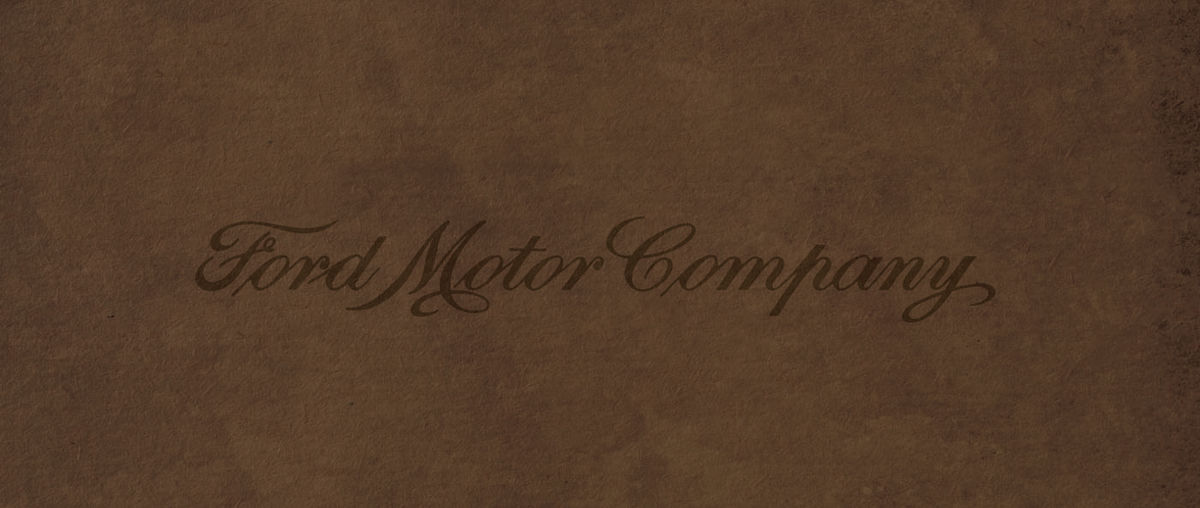Observing Henry Ford’s 150th
Next Time You Slide Behind the Wheel of Your Favorite Ride... ...Remember That Henry Helped to Put You There.
SOMETIME, JUST FOR the fun of it, stop several people at random and ask them who invented the automobile. You already know that at least a few of those folks will readily answer: “Why, it was Henry Ford.”
Actually, it’s an opinion held by many. There even was a country song released in 1973 called “Lord, Mr. Ford.” That tune took a semi-lighthearted jab at the tribulations that accompany vehicle ownership and laid the blame at Mr. Ford’s doorstep. In part it referred to “...that demon automobile...A metal box with the Polyglas wheel...The end result to the dream of Henry Ford.” We, of course, know that’s not true. The senior Mr. Ford didn’t invent the motorcar, nor did he build the earliest of the drivable machines that shuddered and sputtered around the rutted roads of the U.S. and Europe more than a century ago.
But while he wasn’t the initial driving force behind “that demon automobile,” Henry Ford, perhaps more than any other single person, was responsible for launching an industry that is now global in scope and has played a major role in shaping our society and everyday way of life.
So whether or not you’re a fan of Ford Motor Co. products, it’s only fitting that auto enthusiasts give some thought to the life and accomplishments of the company’s founder this year, the 150th anniversary of his birth.
Some Personal Flaws
Like any person, famous or otherwise, Henry Ford certainly had his own set of faults that led to misjudgments over the years. And since he was in a position of authority in the industrial world, those missteps proved to have major repercussions for his company and people involved with it.

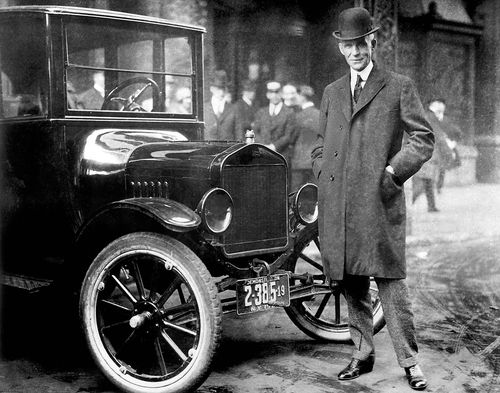
For example, consider his stubborn refusal to give up on his cherished Model T, even as the rest of the industry, particularly General Motors, moved forward with updated products. His tenacity with the T almost put the Ford Motor Co. out of business, and when he finally agreed that a new product was necessary, he simply shut down most of his operations in May of 1927, putting thousands of factory and office workers on immediate layoff. It wasn’t until the end of the year that the Model A started to come off of the assembly lines.
There are other instances such as this that can and have been discussed at length, but on this occasion why don’t we just recognize that certain personal faults did exist and for now we’ll dwell instead on some of the more positive aspects in the life of this noted industrialist.
An Early Interest In Machinery
Henry Ford was born on July 30, 1863 on his family farm in Dearbornville, Springfield Township, Michigan, or what is now Dearborn, site of the Ford Motor Co. headquarters and the massive Ford Rouge manufacturing complex. At the time, of course, horsepower came from four-legged animals but farm boy Henry showed an early interest in mechanics and by the time he was 12 he had assembled a small shop of his own. At age 15, he built his first steam engine.
Ford moved to nearby Detroit as a young man and became a machinist’s apprentice. After his apprenticeship, he held a job setting up and repairing steam engines and in July 1891 he joined the Edison Illuminating Co. of Detroit as an engineer and became chief engineer on Nov. 1, 1893.

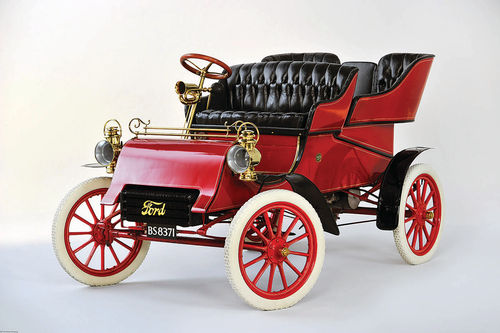
He had married Clara J. Bryant of Greenfield, Michigan, on April 11, 1888 and their one son, Edsel, was born on Nov. 6, 1893, just days after Ford’s promotion at the Edison Co.
Given the fact that he now had a family and a good job, it would not have been surprising if Ford had settled into the life he had achieved and spent his days earning a living at Edison and supporting his wife and son.

The Automotive Lure
But instead of settling into a quiet domestic life, in that same winter of 1893 he built a small one-cylinder gasoline engine in his home at 58 Bagley Ave. near downtown Detroit.
Ford took a later version of that engine, teamed it with a frame and four bicycle wheels and the result was the Quadricycle, his first car. He built that vehicle in a brick shed behind his house and yes, the story you’ve heard about that shed is true. It seems that when the Quadricycle was completed, Ford realized it was too wide to go through the shed’s door. So he took an axe and smashed some bricks from the wall to widen the doorway.
His first Quadricycle ride, on June 4, 1896, lasted for only a few blocks before the vehicle experienced ignition troubles and stalled. But he had managed to build a working automobile, and that showed him a new path in life.
In fact, as the story goes, Thomas Edison himself encouraged Ford to keep working on his vehicle when the two met at a company convention in New York City. Upon hearing of Ford’s accomplishment, Edison reportedly told the young engineer, “That’s the thing! Keep at it!”
Ford did just that and his automotive work attracted financial backing which led to the formation of the Detroit Automobile Co. That company failed, however, as did a second automotive company involving Ford.
But then on June 16, 1903, Ford helped to organize the Ford Motor Co., the same FoMoCo that’s in existence today…although that company came close to folding as well.
Just one month after the Ford Motor Co. was formed, it found itself with cash reserves of a little less than $250. Even in 1903, that wasn’t enough to keep a company afloat for long.
Fortunately for all involved, three orders — along with deposits and payments totaling $1320 — came in for the company’s first vehicle offering, the Model A (not, of course, to be confused with the better-known Model A of nearly three decades later).
Only one of those three important cars remains and it recently was purchased by Henry’s great-grandson, Bill Ford, the company’s current executive chairman.
Praise From the Automotive Press
That first version of the Model A, seen on this page, had a 72-inch wheelbase, weighed about 1250 pounds, had a two speed transmission and was powered by a 100 cid two-cylinder engine rated at 8 horsepower.
And while we’re used to seeing members of the automotive media gush over the latest products from the automakers, it’s interesting to learn that this type of reporting is not a recent invention. Consider this unabashed praise from the August 1903 issue of Cycle and Automobile Trade Journal regarding that early Model A:
“When in motion there is a light purring of the gear to be heard if one listens for it; there is absolutely no vibration to be felt; the riding is perfectly smooth and agreeable.
“The wagon is, of course, under entire control, and is extremely handy in a crowded street, and, taken all in all, this latest of American wagons offered leaves very little indeed to be desired.
“There will undoubtedly be advances in the art, but there will never be any wagon much more comfortable for its passengers than the Ford, and the machine work is excellent, everything being finished and secured in a workmanlike manner.
“The Ford Company finishes the bodies itself, and the external appearance is extremely good.”
As an aside, if the writer of this article were to drive a post-war vehicle, one has to wonder if he still would proclaim that “there will never be any wagon much more comfortable for its passengers” than that 1903 Ford.
A Far-Ranging Career
In fact, the writer of that review of the 1903 Ford would only have to wait five years for a more remarkable car to come along as the Model T debuted in 1908 and truly changed the nature of the automotive business. It was the type of car you would expect from a practical farmer who had to rely on his machinery. It was relatively low-cost, reliable and simple in its design so it could be maintained by its owner. Not only that, it was tough enough to handle the poor roads of its day. Some 15 million Model Ts were built and as has been said time and again, this was the car that “put the nation on wheels.”
To build even more of the popular Model Ts, in 1913 Ford Motor installed an integrated moving assembly line in its new Highland Park, Michigan, plant. Conveyors and overhead hangers brought parts to the moving assembly line, thus increasing production and lowering the cost of the cars.
In 1914 Ford introduced its famous $5-a-day wage for assembly workers. That more than doubled their previous pay, cut employee turnover and helped to start building a middle class that eventually could afford to buy the vehicles they built.
After bringing out the Model A in 1928, Ford made another step forward four years later with its V-8 for the mass market. Yes, some of the earliest of these engines had to be rebuilt before long, but mass-market V-8 power was the start of yet another important trend in the industry.
Leaving the Business
Henry Ford turned the presidency of Ford Motor over to his son Edsel in 1919 but stayed involved in the company. He returned as president in 1943 after Edsel’s death from cancer. This time, however, Henry’s hold wasn’t as firm as it had been in the past and the company again was finding itself in a precarious position. After some extremely strong urging from his wife Clara and daughter-in-law Eleanor (Mrs. Edsel Ford), Henry turned over the presidency to his grandson, Henry Ford II, and retired for good.

Life at Fair Lane
Although Henry and Clara Ford lived in an upscale section of Detroit for a time after their fortunes increased with the growth of Ford Motor, their desire for privacy led them to purchase a 1300-acre tract of land approximately two miles from Henry’s birthplace in Dearborn. They built a 56-room residence there and it became their home in 1916. They called the home and estate “Fair Lane” after an area in County Cork, Ireland, the birthplace of Ford’s foster grandfather, Patrick Ahern.
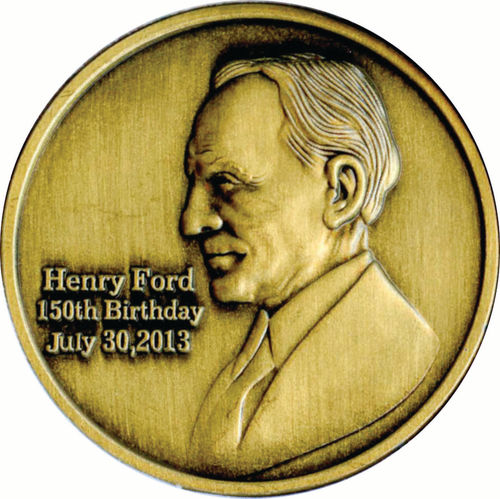
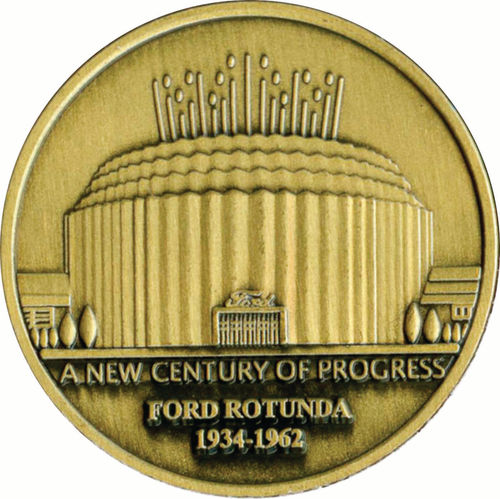
Henry Ford died at Fair Lane on April 7, 1947 following a cerebral hemorrhage at age 83. Ironically, heavy rains and flooding had cut off power to the estate and kerosene lamps and candles were the only source of light in the Ford house, much as it had been in the home where he was born nearly a century before.
An Anniversary Keepsake
If you’re looking for a little something to help you mark this important year in automotive history, The Early Ford V-8 Foundation has issued a Commemorative Coin that’s now available.
This gold-finished 1.25-inch coin is a licensed product of the Ford Motor Co. and one side carries a likeness of Henry Ford while the back “pays homage” to his iconic show building, the Rotunda. The coin comes in a protective trifold that lists some of Ford’s accomplishments and tells the story of the ill-fated Rotunda that burned in 1962. The coin retails for $9.95 and can be ordered from henryfordcoin.com or fordv8foundation.org.
The Early Ford V-8 Foundation was createdin 1991 to help preserve “1932- 1953 Early Ford V-8 History.”

